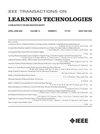Children's AI Design Platform for Making and Deploying ML-Driven Apps: Design, Testing, and Development
IF 2.9
3区 教育学
Q2 COMPUTER SCIENCE, INTERDISCIPLINARY APPLICATIONS
引用次数: 0
Abstract
The rapid advancement of artificial intelligence and its increasing societal impacts have turned many computing educators' focus toward early education in machine learning (ML). Limited options for educational tools for teaching novice learners about the mechanisms of ML and data-driven systems presents a recognized challenge in K–12 computing education. In response, we introduce “GenAI Teachable Machine,” a visual, data-driven design platform aimed at introducing novice learners to fundamental ML concepts and workflows, particularly in the context of classifiers. Following the design science research (DSR) method, this study presents the prior recommendations, standards, codevelopment, and extensive field testing that resulted in a platform enabling young learners to express their own interest-driven ideas through codesigning and sharing personally meaningful apps. The platform improves on the design of Google's popular Teachable Machine 2 by its ability to create a standalone app by defining one or more actions to be triggered by each classifier result, and deploy that app to other devices. It also enables one to distribute the collection of training data among many users. In addition to the DSR process, this article presents findings from usability lab tests (儿童AI设计平台,用于制作和部署ml驱动的应用程序:设计,测试和开发
人工智能的快速发展及其日益增加的社会影响使许多计算机教育工作者将重点转向机器学习(ML)的早期教育。有限的教育工具可供初学者学习机器学习和数据驱动系统的机制,这在K-12计算教育中是一个公认的挑战。作为回应,我们推出了“GenAI可教机器”,这是一个可视化的、数据驱动的设计平台,旨在向新手学习者介绍基本的ML概念和工作流程,特别是在分类器的背景下。本研究遵循设计科学研究(DSR)方法,提出了先前的建议、标准、共同开发和广泛的现场测试,从而形成了一个平台,使年轻学习者能够通过共同设计和分享个人有意义的应用程序来表达自己的兴趣驱动想法。该平台改进了b谷歌流行的teatable Machine 2的设计,它能够通过定义每个分类器结果触发的一个或多个操作来创建一个独立的应用程序,并将该应用程序部署到其他设备上。它还允许在许多用户之间分发训练数据集合。除了DSR过程,本文还介绍了可用性实验室测试(N = 8)和涉及四年级和七年级儿童的6小时课堂项目(N = 213)的结果。结果表明,没有机器学习经验的孩子能够在工作流程中导航,并将自己的想法转化为具体的基于机器学习的应用程序。大多数孩子能够用他们自己的语言,用数据驱动(设计)的思维概念和见解来反映和呈现他们的工作过程。
本文章由计算机程序翻译,如有差异,请以英文原文为准。
求助全文
约1分钟内获得全文
求助全文
来源期刊

IEEE Transactions on Learning Technologies
COMPUTER SCIENCE, INTERDISCIPLINARY APPLICATIONS-
CiteScore
7.50
自引率
5.40%
发文量
82
审稿时长
>12 weeks
期刊介绍:
The IEEE Transactions on Learning Technologies covers all advances in learning technologies and their applications, including but not limited to the following topics: innovative online learning systems; intelligent tutors; educational games; simulation systems for education and training; collaborative learning tools; learning with mobile devices; wearable devices and interfaces for learning; personalized and adaptive learning systems; tools for formative and summative assessment; tools for learning analytics and educational data mining; ontologies for learning systems; standards and web services that support learning; authoring tools for learning materials; computer support for peer tutoring; learning via computer-mediated inquiry, field, and lab work; social learning techniques; social networks and infrastructures for learning and knowledge sharing; and creation and management of learning objects.
 求助内容:
求助内容: 应助结果提醒方式:
应助结果提醒方式:


